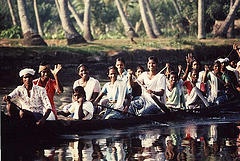Today President Obama announced the United States and 30 other nations have committed to join together to achieve the targets of the Global Health Security Agenda (GHSA). APHL is proud to be a key partner in the effort to make the world safe from infectious disease threats.
APHL is working closely with US federal agencies as well as domestic agencies within African and Asian partner nations to achieve the following GHSA targets:
- Countering antimicrobial resistance
- Preventing the emergence and spread of zoonotic disease
- Advancing a whole-of-government national biosafety and biosecurity system in every country
- Establishing a national laboratory system
- Strengthening real-time biosurveillance
- Advancing timely and accurate disease reporting
- Establishing a trained global health security workforce
- Establishing emergency operations centers
APHL in Africa
Guinea, Kenya, Liberia, Sierra Leone, Tanzania, Uganda
To address the limited laboratory capacity and capability in many African nations, we are currently partnering with the African Society of Laboratory Medicine (ASLM) to provide technical and management assistance for design, development and implementation of the African Public Health Laboratory Network (APHLN). Working with ASLM, APHL will convene stakeholders to develop the operational rules for the network, support laboratory accreditation and set goals for national public health laboratories. We will leverage existing laboratory models, notably the US Laboratory Response Network (LRN), to design an effective laboratory network for the continent.
As our GHSA work moves forward, APHL is also planning to initiate laboratory assessments, inventory and review of laboratory policies, training and mentoring of laboratory staff, support for development of biosafety facilities, and review of specimen referral systems, quality management system programs and capacity for detecting anti-microbial resistance.
APHL in Asia
India, Indonesia, Vietnam
In Asia, APHL is working directly with ministries of health and other national health officials to develop laboratory systems capable of safely and accurately detecting and characterizing pathogens causing epidemic disease. Lucy Maryogo-Robinson, APHL’s global health director, is traveling to partner countries in southeast and central Asia to plan activities under GHSA. In November she traveled with an APHL team to Vietnam to discuss projects to expand APHL’s longstanding relationship with that country. Ongoing development of informatics systems and strengthening of capacity to respond to infectious diseases will be priorities.




 By Benjamin Waldmann Selvarasu, a coconut farmer in Erode, India, met his fate with a bite from a Russell’s viper. With his life hanging in the balance, it wasn’t until he reached a third
By Benjamin Waldmann Selvarasu, a coconut farmer in Erode, India, met his fate with a bite from a Russell’s viper. With his life hanging in the balance, it wasn’t until he reached a third The nesting grounds of sauropod dinosaurs where absolutely astonishing, covering hundreds of square miles in cases, forming vast playgrounds to rear their young. Some of the most exquisitely preserved sauropod hatcheries are from Jabalpur in
The nesting grounds of sauropod dinosaurs where absolutely astonishing, covering hundreds of square miles in cases, forming vast playgrounds to rear their young. Some of the most exquisitely preserved sauropod hatcheries are from Jabalpur in

